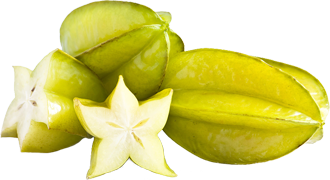|
Star fruit is one
of the very low calorie exotic fruits. 100 g fruit just provides 31 calories,
which is much lower than for any other popular tropical fruits. Nonetheless, it
has an impressive list of essential nutrients, antioxidants, and vitamins
required for well-being.
The fruit along
with its waxy peel provides a good amount of dietary fibre. Fibre helps prevent
absorption of dietary LDL cholesterol in the gut. The dietary fibres also help
protect the mucous membrane of the colon from exposure to toxic substances by
binding to cancer-causing chemicals in the colon.
Star fruit
contains good quantities of vitamin-C. Vitamin C is a powerful natural
antioxidant. 100 g of fresh fruit provides 34.7 mg or 57% of daily-required
levels of vitamin C. In general, consumption of fruits rich in vitamin C helps
the human body develop resistance against infectious agents and scavenge harmful,
pro-inflammatory free radicals from the body.
Star fruit is
rich in antioxidant phyto-nutrients polyphenolic flavonoids. Some of the
important flavonoids are quercetin, epicatechin, and gallic acid. Total
polyphenol contents (Folin assay) in this fruit are143 mg/100 g. These
compounds help protect from deleterious effects of oxygen derived free radicals
by warding them off the body.
In addition, the
fruit is a good source of B-complex vitamins such as folates, riboflavin, and
pyridoxine (vitamin B-6). Together, these vitamins help as co-factors for
enzymes in metabolism as well as in various synthetic functions inside the
body.
It also contains
small amount of minerals and electrolytes like potassium, phosphorus, and zinc
and iron. Potassium is an important component of cell and body fluids helps
controlling heart rate and blood pressure; thus, counters bad influences of
sodium.
Antioxidant
activity: The strong correlation was shown between the
antioxidant activity and total phenolics and proanthocyanidins contents. Fewer
amounts of flavonoids are found in the fruit whereas the correlation between
antioxidant activity and ascorbate content was found poor. Carambola possesses
huge phenolic antioxidants that provide health benefits. The huge presence of
phenolics and antioxidant activity provides various benefits to the health when
it is used in functional food products.
Anti-microbial and
antifungal activity: The extract of ethanol, butanol
fractions, ethyl acetate, hexane and flavonoids such as fucopyranoside from the
leaves of carambola is used for the purpose of anti-inflammatory. The extract
of ethanol lowered edema when it is taken in dose dependent manner. The ethanol
extract also prevented the Myeloperoxidase activity.
Antitumor activity: The study conducted on the cultured cells of Carambola concluded
that it has possessed the ability to hydroxylate sesquiterpene compounds in a
region and steroselective manner. The research was made on the brain tumour
cells with the alcoholic extract from the carambola stems but the leaves
extract was efficient against the liver carcinoma cells.
Antiulcer activity: The water alcohol extract of the leaves of Carambola was
examined about the potential of anti-ulcerogenic. When the research was
conducted on rats, it does not showed the indomethacin and acute stress
ulcerogenic models which shows that the presence of ethanolic extract of
Carambola possess lower anti-ulcer activity.
Hypotensive
activity: The hypotensive effect was studied on the
isolated rat aorta with the aqueous extract. It reduces the induced
contractions and contractile mechanisms. The conclusion derived from the
aqueous extract shows its hypotensive nature.
Nephrotoxic effect: The study about the effects of Carambola on the patients of
renal failure shows that the fruit and its juice may urge neurotoxicity and
nephrotoxicity. The patients of chronic disease should avoid carambola. Those
having normal renal function should also avoid the consumption of fruit or
juice on an empty stomach.
Analgesic: The study which was conducted on the analgesic activity of the
Carambola fruit shows that it shows the significant central and peripheral
analgesic activities in acetic acid.
Hypoglycaemic: The pulp of ripe Carambola possesses the hypoglycaemic effect
which reduces the levels of blood glucose. The report shows that the dietary fibres,
alcohol insoluble solid and water insoluble solid segregated from the pomace of
Carambola acquire the hypoglycaemic effects.
Anthelmintic: Carambola leaves showed an anthelmintic activity in dose
dependent manner which shows the time of paralysis in 10 minutes and the death
in 16 minutes in 100 mg/ml concentration.
Hypocholesterolaemic & Hypolipidemic
activity
The report on an isolated water-insoluble fibre
rich fraction (WIFF) in the star fruit pomace shows the hypolipidamemic and
hypocholesterolaemic activity. It reduces the cholesterol and lipid by
promoting the extraction of cholesterol and bile acids. It reduces the
triglycerol in serum, liver cholesterol and raises the cholesterol, total
lipids and bile acids.
|

